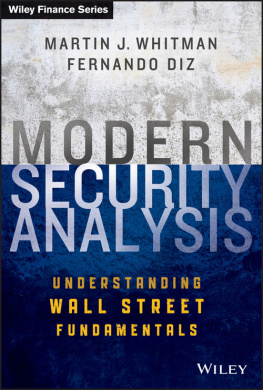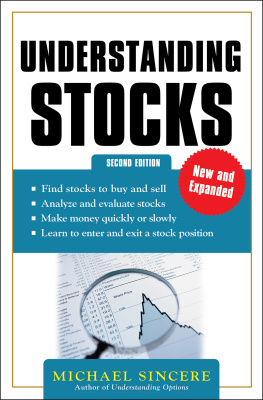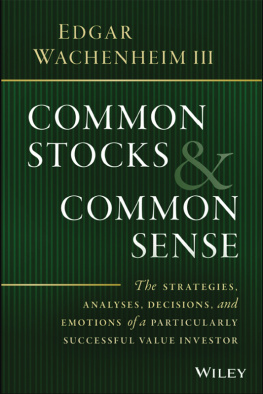Founded in 1807, John Wiley & Sons is the oldest independent publishing company in the United States. With offices in North America, Europe, Australia, and Asia, Wiley is globally committed to developing and marketing print and electronic products and services for our customers professional and personal knowledge and understanding.
The Wiley Finance series contains books written specifically for finance and investment professionals as well as sophisticated individual investors and their financial advisors. Book topics range from portfolio management to e-commerce, risk management, financial engineering, valuation and financial instrument analysis, and much more.
For a list of available titles, visit our Web site at www.WileyFinance.com .

Cover Design: Paul McCarthy
Cover Image: ASSALVE/iStock
Copyright 2013 by Martin J. Whitman and Fernando Diz. All rights reserved.
Published by John Wiley & Sons, Inc., Hoboken, New Jersey.
Published simultaneously in Canada.
No part of this publication may be reproduced, stored in a retrieval system, or transmitted in any form or by any means, electronic, mechanical, photocopying, recording, scanning, or otherwise, except as permitted under Section 107 or 108 of the 1976 United States Copyright Act, without either the prior written permission of the Publisher, or authorization through payment of the appropriate per-copy fee to the Copyright Clearance Center, Inc., 222 Rosewood Drive, Danvers, MA 01923, (978) 750-8400, fax (978) 646-8600, or on the Web at www.copyright.com . Requests to the Publisher for permission should be addressed to the Permissions Department, John Wiley & Sons, Inc., 111 River Street, Hoboken, NJ 07030, (201) 748-6011, fax (201) 748-6008, or online at www.wiley.com/go/permissions .
Limit of Liability/Disclaimer of Warranty: While the publisher and author have used their best efforts in preparing this book, they make no representations or warranties with respect to the accuracy or completeness of the contents of this book and specifically disclaim any implied warranties of merchantability or fitness for a particular purpose. No warranty may be created or extended by sales representatives or written sales materials. The advice and strategies contained herein may not be suitable for your situation. You should consult with a professional where appropriate. Neither the publisher nor author shall be liable for any loss of profit or any other commercial damages, including but not limited to special, incidental, consequential, or other damages.
For general information on our other products and services or for technical support, please contact our Customer Care Department within the United States at (800) 762-2974, outside the United States at (317) 572-3993 or fax (317) 572-4002.
Wiley publishes in a variety of print and electronic formats and by print-on-demand. Some material included with standard print versions of this book may not be included in e-books or in print-on-demand. If this book refers to media such as a CD or DVD that is not included in the version you purchased, you may download this material at http://booksupport.wiley.com . For more information about Wiley products, visit www.wiley.com .
Library of Congress Cataloging-in-Publication Data:
Whitman, Martin J.
Modern security analysis : understanding Wall Street fundamentals / Martin J. Whitman, Fernando Diz.
pages cm. (Wiley finance series)
Includes index.
ISBN 978-1-118-39004-7 (cloth); 978-1-118-60265-2 (ebk); 978-1-118-60301-7 (ebk); 978-1-118-60338-3 (ebk)
1. Investment analysis. I. Diz, Fernando, 1956. II. Title.
HG4529.W487 2013
332.632042dc23
2013000737
To the Deans, Faculty, Staff, Students and Alumni of
The Whitman School of Management
at
Syracuse University
Acknowledgments
There are so many people who contributed to our knowledge, and to the specifics of this book, that it is impossible to acknowledge and thank all of them. We have singled out a few names but in doing so have no intent of shortchanging those contributors who we fail to mention.
At Syracuse University we are especially grateful for the help and advice given to us by Deans Mel Stith and Tom Foley; Professors Bill Walsh and Randy Elder; students in the Orange Value Fund programall at the Whitman School of Management; University Trustees and alumni Dick Haydon, Steve Ballentine, Bernard Kossar, Mike Dritz, John Couri, Steve Barnes, Ken Goodman, and Jay Genzer.
At Third Avenue Management, we benefited much from advice rendered by David Barse, Tom Gandolfo, Vinny Dugan, and Hal Drachman. Bridget Wysong also was helpful. This book never would have seen the light of day without the herculean efforts of Beth Connor, executive assistant to Martin Whitman and Betty Ross, administrator of the Ballentine Investment Institute and the Orange Value Fund program coordinator at the Whitman School of Management.
One faculty member at Syracuse University Law School, Gregory Germain , and two at the Yale University School of Management, Stan Gartska and Martin Shubik, have to be singled out for their contributions. Others worthy of mention are Ronnie Chan, Bruce Flatt, Bruce Greenwald, and Arnie Jacobs.
It ought to be noted that both of us learned a lot from people we came to believe were bad guys and with whom we would never again invest. We wont name names but rather just acknowledge that one tends to learn more from ones mistakes than from ones successes.
Also, our students at Syracuse, Yale, and Columbia contributed much to our knowledge. Quite possibly we learned more from them than they learned from us.
Finally, thanks to our families, especially Lois Whitman and Josefa Alvarez.
The errors and shortcomings of this book belong to us alone, not at all to the various contributors.
Martin J. Whitman
Fernando Diz
Introduction
OUR FOCUS
This book is different from other books published about securities investing, securities trading, and academic finance as embedded in modern capital theory (MCT). It seems to us that all other books on investing and academic finance ranging from Principles of Corporate Finance (McGraw-Hill, 2002) by Brealey and Myers to Security Analysis: Principles and Technique (America Media International, reprinted 2003) by Graham, Dodd, and Cottle (G&D), and to tracts on trading techniquesfocus on forecasting and explaining short-run market prices, especially prices at which securities are traded in markets populated by outside passive minority investors (OPMIs). This book, in sharp contrast, focuses strictly on explaining and understanding commercial enterprises and the securities they issue. For us, short-run market prices in OPMI markets are so-called random walks except for the special cases of sudden-death securities such as options, warrants, certain convertibles, and risk arbitrage situations where there will be relatively determinate workouts in relatively determinate periods of time.
It seems to us that our approach became more relevant as a consequence of the 20082009 meltdown, whereas MCT and G&D approaches became less relevant.
In this book the emphasis is on creditworthiness rather than earnings and cash flows, the appraisals of managements not only as operators but also as investors and financiers, and understanding the motivations and practices of activists.
CREDITWORTHINESS
Throughout the book we emphasize the importance of creditworthiness. Three elements go into the determination of creditworthiness for functional purposes:








